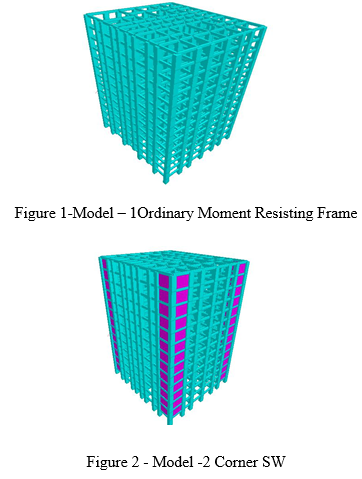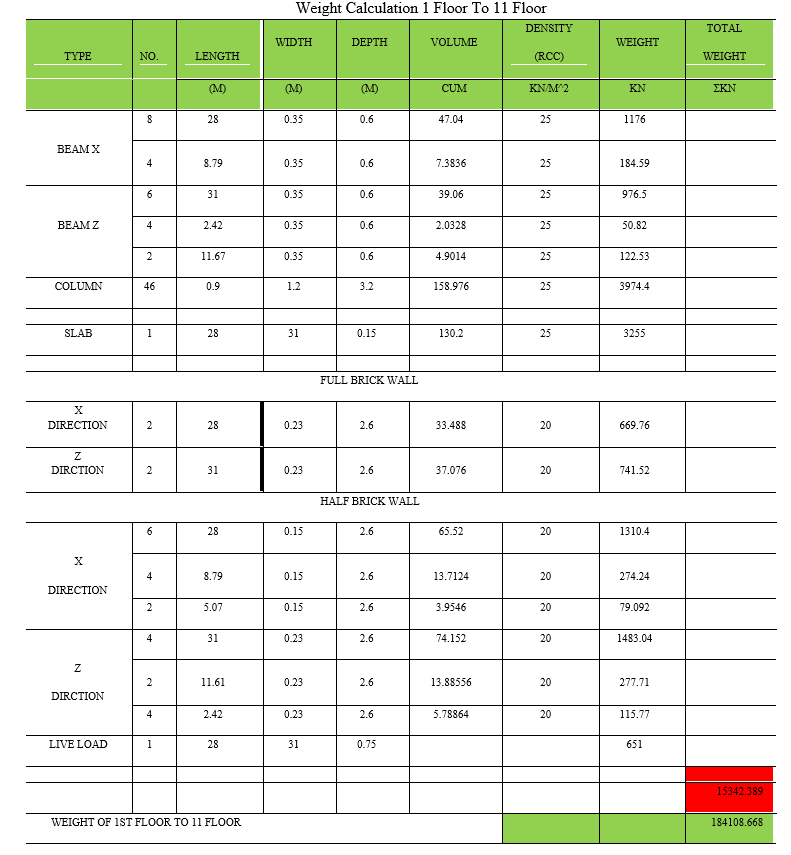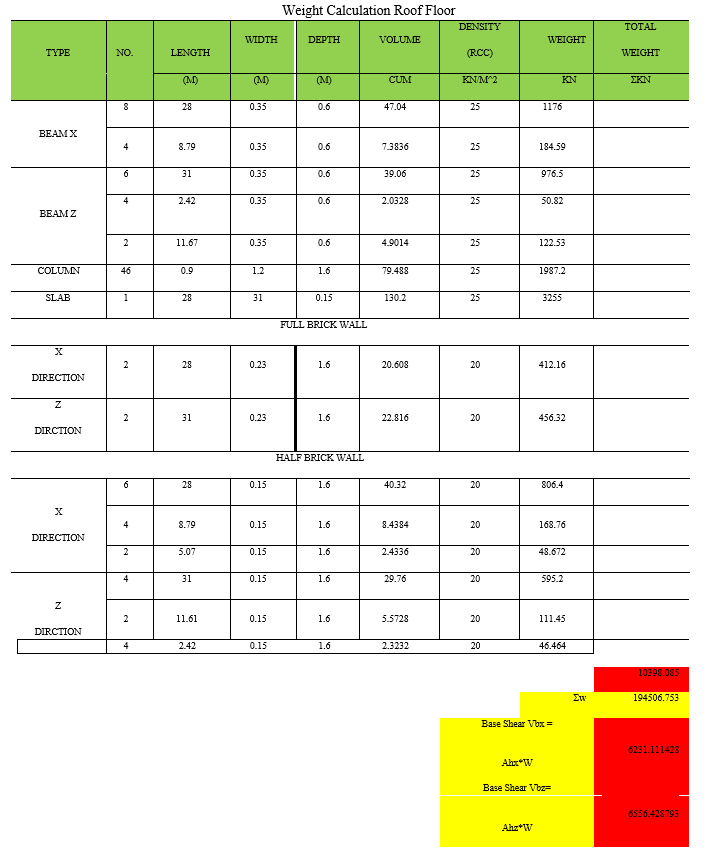Ijraset Journal For Research in Applied Science and Engineering Technology
- Home / Ijraset
- On This Page
- Abstract
- Introduction
- Conclusion
- References
- Copyright
Comparative Analysis of Lateral Loads Resisting System for RCC Structure
Authors: Sharad Shrirame, Prof. Sanjay Dhenge, Prof. Girish Sawai
DOI Link: https://doi.org/10.22214/ijraset.2022.42719
Certificate: View Certificate
Abstract
This research work focuses on comparison of seismic analysis of G+12 story buildings stiffened with shear wall at various locations. The performance of the building is analysed in Zone II, for Mumbai city. This research paper includes understanding the main zone factor that tends the structure to perform poorly during lateral moments caused by earthquake in order to achieve their appropriate behaviour under future earthquakes. The analysed structure is symmetrical, G+12, Ordinary RC moment-resting frame (OMRF). Modelling of the structure is done by using staad proV8i software. The Time period used for the seismic calculations of the structure in both the direction is achieved from the software and as per IS 1893(part I):2016 seismic analysis has conducted. The Lateral seismic forces of RC frame are carried out using equivalent static method as per IS 1893(part I): 2016. The purpose of present work is to understand that the structures need to have suitable Earthquake resisting features to safely resist large lateral forces exerted on structure during lateral movement of structure. Shear walls are efficient (model no.3), In terms of effectiveness in minimizing lateral movement and damage caused due to the earthquake in structure the conventional frame system also provides the resistance to structure but it is unable to minimise the damage caused by the earthquake in structure. A comparative analysis is done in terms of Base shear, Displacement, Axial load, Moments in Z direction in columns and maximum bending moments in beams.
Introduction
I. INTRODUCTION
India is the fast growing economy in the world and it does require infrastructure facility along with the rapid growth of population in our country.
These types of structures help to increase life of structure, stiffness of structure and strength of structure. We have been studying this project since 5 to 6 month and we gain the knowledge of different IS code and different Software. There are fluctuations in axial force, Absolute displacement, Torsion and moment in Z direction. This demands changes in the current structural system which needs to be implemented to resist these forces. Many research has been carried which describes the suitability of various lateral load resisting system against deformation and shear exerted due to the earthquake and wind force. It is necessary to consider the seismic load for the design of high rise structure. The different lateral load resisting system are used in medium-rise building as the lateral load due to earthquake are a matter of concerned whereas building height increase the importance of lateral load action rise in an accelerating rate.
Types of lateral load
- Wind Loading: The horizontal load used in design of a structure to account for the effect of wind. Wind load is one of the critical laterals loading for modern tall building, which have light weight skeletons that cause uncomfortable horizontal moments for occupants. Also, wind is not constant either with height or with time and is not uniform over side of a building. The height of building is above 10 m then wind load is considering as per IS 875 (Part 3) 1987.
- Seismic Loading: Assume lateral load an earthquake might cause to act upon structural system in any horizontal direction where, excessive vibration due to horizontal loads is a major factor in design and construction of modern tall building. The main reason to provide the seismic load is resisting the earthquake wave in perpendicular direction of building as per IS 1893 (Part 1) 2016.
II. LITERATURE REVIEW
A. “Study of different lateral load resisting system”
Abhijeet Baikerikar, KanchanKanagali. International Journal of Innovation Research in Science, Engineering and Technology (An ISO 3297: 2007 Certified Organization) vol. 6, Issue 4, v April 2017.pg- 201-204
In this paper the study of shear wall, Bracing, Moment Resistance Frame is done. How we will overcome this lateral loading system acting on High Rise Building for the best result is also is shown in this paper. According to architecture point of view we must check the building for all types of loads (seismic load, lateral load, shear wall, wind load etc.) seismic zone plays an important role in the earthquake resistant design of building structure because the zone factor changes as the seismic intensity changes from low to very severe.
As the building height increases Lateral displacements and drift increases. Lateral displacements and drift is significantly lower after inserting shear wall and bracings in the bare frame. Base Shear is decreased as the time period increases. Time period significantly lowered after placing shear walls and bracings.
B. “Lateral loads analysis of RCC building”
M.D.Kavadkar, P.B. Kodag,M.E (Structure) student, Department of Civil Engineering, Singhad College of Engineering, Pune International Journal of Modern Engineering Research (IJMER) ISSN: 2249-6645 Volume:3, Issue:3 May-June 2013 pg-1428-1434
The Structure is high seismic areas may be susceptible to the serve damage. Along with gravity load structure has to withstand to lateral load which can be develop high stresses. Now a day, shear wall in RC structure and steel bracing in steel structure are most popular system to resist lateral load due to earthquake, wind etc. The shear wallis the one of the best lateral load resisting system which is widely used in construction world but use of steel bracing will be the solution for enhancing the earthquake resistance. The performance of the building is Demand Capacity. It is found that the X type of steel bracing system significantly contributes to the structural stiffness and reduced the maximum inter storey drift, lateral displacement and demand capacity.
G+ 12 bare frame model, shear wall model and Steel bracing model is analysed using standard software. The lateral displacement of the building is reduced by 40 to 60 % by the use of shear wall Type-III and X Type steel bracing system. Capacity of the steel braced structure is more as compare to the shear wall structure. Steel bracing has more margin of safety against collapse as compare with shear wall.
???????C. “Comparative analysis between different commonly used lateral load resisting systems in reinforced concrete building”
Global Journal of Research’s in engineering (Civil & Structural Engineering) Volume 16 Issue 1 Version 1.0 Year 2016 Type: Double Blind Peer Reviewed International Research Journal Publisher: Global Journals Inc. (USA) Online ISSN:2249-4596 & Print ISSN: 0975-5861 pg-488-490
The concept of tall structure is not new to the world, yet the trend of high-rise construction started in the 19th century. High-rise & Multi-storey building are being constructed either to cater and growing population or as a landmark to boost a country’s name and get recognition. Any structure, to be reliable and durable, must be designed to withstand gravity, wind, earthquake, equipment and snow load, to be able to resist high or low temperatures and to and to vibrations and absorb noises. This has brought more challenges for the engineer to cater both gravity loads as well as lateral loads earlier building was designed for the gravity loads but now, because of height and seismic zone, the engineer has taken as of lateral loads due to earthquake and wind forces.
Bracing type of lateral load resisting system is most effective in reducing displacements & forces in the members is economical way of increasing the lateral stiffness of the building.
Capacity of steel braced structure more as compare to the shear wall structure. Shear force in beam was found least in bracing lateral load resisting system as compare to shear wall moment resisting frame.
III. INTRODUCTION TO STAAD SOFTWARE
Staad-Pro is structural analysis design program software. It includes a state of the art user interface, visualization tools and international design codes. It is used for 3D model generation, analysis and multi-material design.
Analyse gravity and lateral loads: Design and analyse simple or complex structures for a wide range of loading conditions, including those induced by gravity such as dead and live loads, including skip conditions, in combination with lateral loads including wind and seismic.
Design and analysis structural models :quickly model your entire structure, including decks, slabs, slab edges and openings, beams, columns, walls, braces, spread and continuous footings, and pile caps. Effectively automate many of your time-consuming design and analysis tasks and produce practical system and components designs that are document ready.
Design beams, columns and walls: Optimize or analysis beams, columns, and walls for gravity and lateral loads to quickly obtain safe and economical designs. Confidently produce design in compliance with global design specifications and building codes.
Design lateral resisting frames: perform extinctive building code checks for seismic and wind forces on braced frames and moment frames. Quickly obtain safe and reliable designs for all of your structural projects.
Design cold-formed steel members: design light gauge steel members using a comprehensive cold formed section library without needing to use a separate special purpose application.
???????A. Study Of Codal Provisions
- IS 456: 2000
Tensile Strength of Concrete:
The flexural and splitting tensile strengths shall be obtained as described in IS 516 and IS 5816 Respectively. When the designer wishes to use an estimate of the tensile strength from the compressive strength, the following formula maybe used:
Flexural strength, fer=0.7..[l; N/mm2
This is the characteristic cube compressive strength of concrete in N/mm2.
2. Elastic Deformation
The modulus of elasticity is primarily influenced by the elastic properties of the aggregate and to a lesser extent by the conditions of curing and age of the concrete, the mix proportions and the type of cement.
The modulus of elasticity is normally related to the compressive strength of concrete
M-25 grade of concrete and Fe-415 grade of reinforcing steel are used for all the frame models used in this study. Elastic material properties of these materials are taken as per Indian Standard IS 456 (2000). The short-term modulus of elasticity (Ec) of concrete is taken as: Ec = 5000√fck
IV. RESULT AND CALCULATIONS


???????A. Design Of Wind Load Calculation
Design Wind Speed (Vz)
The basic wind speed (V,) for any site shall be obtained from Fig. 1 and shall be modified to include the following effects to get design wind velocity at any height (V), j for the chosen structure:
- Risk level;
- Terrain roughness, height and size of structure; and
- Local topography. It can be mathematically expressed as follows:
Vz= Vb kl k2 k3
where
Vz= design wind speed at any height z in m/s;
kl = probability factor (risk coefficient)
k2 = terrain, height and structure size factor
k3 = topography factor
???????B. Design Of Earthquake Load
When the lateral load resisting elements are oriented along orthogonal horizontal direction, the structure shall be designed for the effects due to till design earthquake load in one horizontal direction at time. When the lateral load resisting elements are not oriented along the orthogonal horizontal directions, the structure shall be designed for the effects due to full design earthquake load in one horizontal direction plus 30 percent of the design earthquake load in the other direction.
Design Spectrum
Provided that for any structure with T <0.1 s, the value of Ah will not be taken less than Z/2 whatever be the value of I/R,
Where,
Z= Zone factor given, is for the Maximum Considered Earthquake (MCE) and service life of structure in a zone. The factor 2 in the denominator of Z is used so as to reduce the Maximum Considered Earthquake (MCE) zone factor to the factor for Design Basis Earthquake (DBE).
I= Importance factor, depending upon the functional use of the structures, characterized by hazardous consequences of its failure, post-earthquake functional needs, historical value, or economic importance.
R= Response reduction factor, depending on the perceived seismic damage performance of the structure, characterized by ductile or brittle deformations. However, the ratio (I/R) shall not be greater than 1.0. The values of R for buildings are given
Sa/g =Average response acceleration coefficient

 ???????
???????
Conclusion
From the study of Comparative Analysis of Lateral Load Resisting System in G+ 12 storied building subjected to Earthquake and Wind, following conclusions can be made. 1) The Absolute displacement, axial force, moment and storey shear in moment frame (Model-I) is the greatest among all lateral load resisting systems investigated. Amongst in dual frames, Model III (Shear wall provided at intermediate side) is the least while other frames have higher values in earthquake. 2) When shear wall provided at corner side and each side at middle, no significant variation in Absolute displacement, axial force and moment. 3) When shear wall provided at middle portion, absolute displacement, axial force and moment is greatest as compared to other dual system model. 4) When shear wall provided at intermediate side, all parameter like absolute displacement, axial force and moment is less as compared to other dual system model. 5) Absolute displacement, axial force and moments in conventional frame system are lesser than earthquake load and wind load case. So it is considered that in comparison wind load case is better than earthquake load case .Hence wind load is less predominant than earthquake load case. 6) The model no. 2 is the economically best as compare to other model.
References
[1] Shruti Badami, M. R. Suresh, “A study on behaviour of structural system for tall building subjected to lateral loads.” International journal of Engineering Research &Technology (IJERT). [2] Ajinkya P. Gadkari, “Review on behavior of outrigger structural system in high rise building.” International journal of Engineering Development of Research. [3] Venkta S. Kumar, Surendra Babu,Usha Kranti, “Shear wall-A review.” International journal of innovative research in science. [4] M. D. Kevadkar,P. B. Kodag, “Lateral load analysis of RCC building.” International journal of Modern Engineering Research (IJMER), Vol.3, Issue3, May-June2013, pg no.1428-1434. [5] TanhaB.Shah, “literature Survey on Analysis of Multi-storey building considering hybrid structure.” International journal of innovative research and development. [6] Tejaswini R. M ,Rashmi A. R, “Analysis and comparison of different lateral load resisting structural forms.” International journal of engineering research and technology. [7] Kiranparmar,Mazhardhankot, “Comparative study between dual system for lateral Load resistance in buildings of variable heights.” International Engineering Research Journal of & Technology, page no. 303-306
Copyright
Copyright © 2022 Sharad Shrirame, Prof. Sanjay Dhenge, Prof. Girish Sawai. This is an open access article distributed under the Creative Commons Attribution License, which permits unrestricted use, distribution, and reproduction in any medium, provided the original work is properly cited.

Download Paper
Paper Id : IJRASET42719
Publish Date : 2022-05-15
ISSN : 2321-9653
Publisher Name : IJRASET
DOI Link : Click Here
 Submit Paper Online
Submit Paper Online

